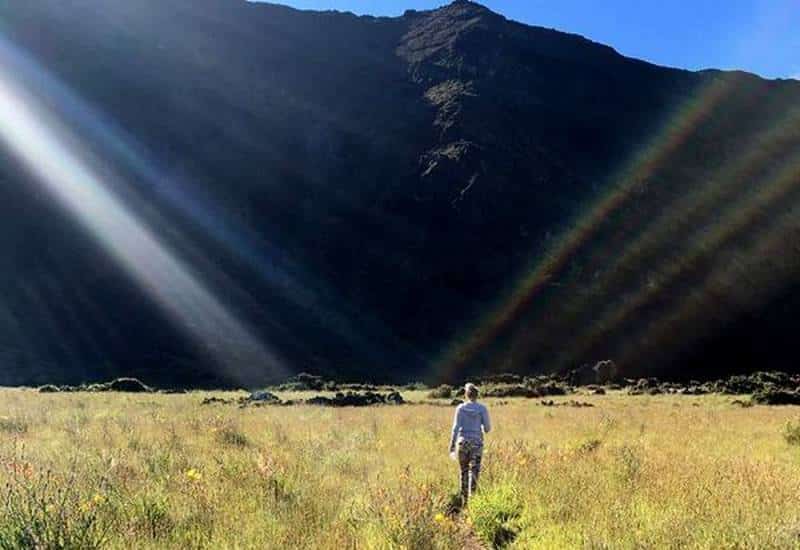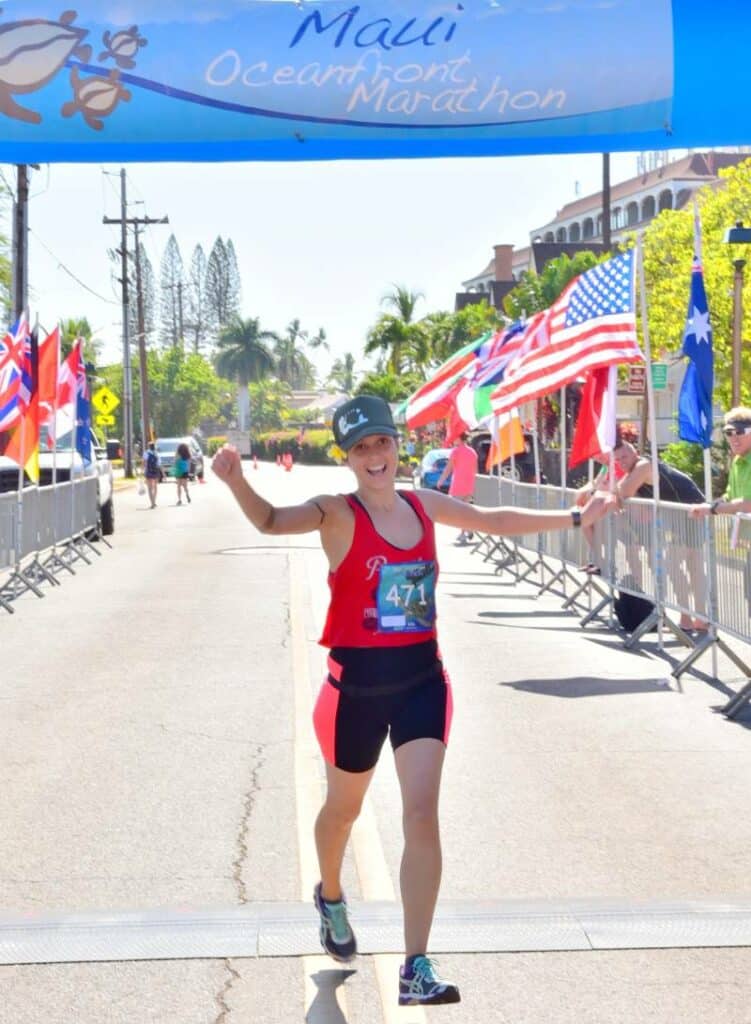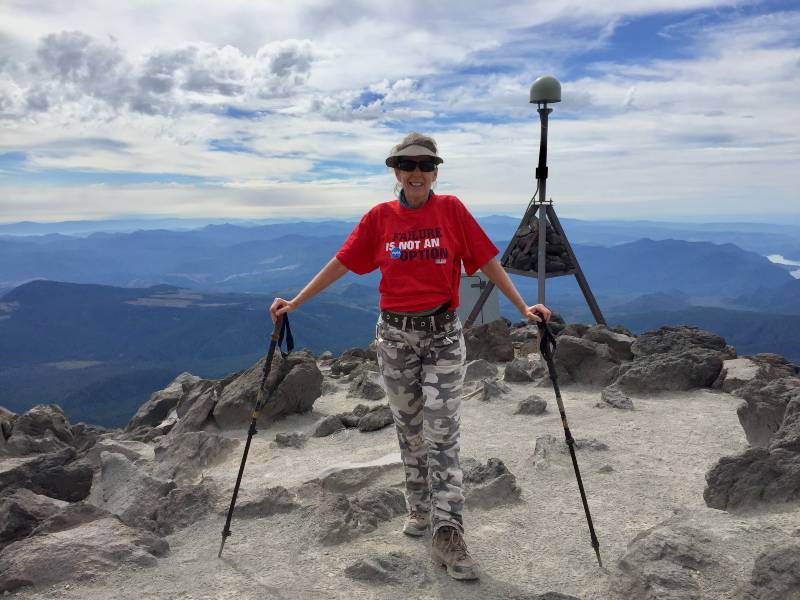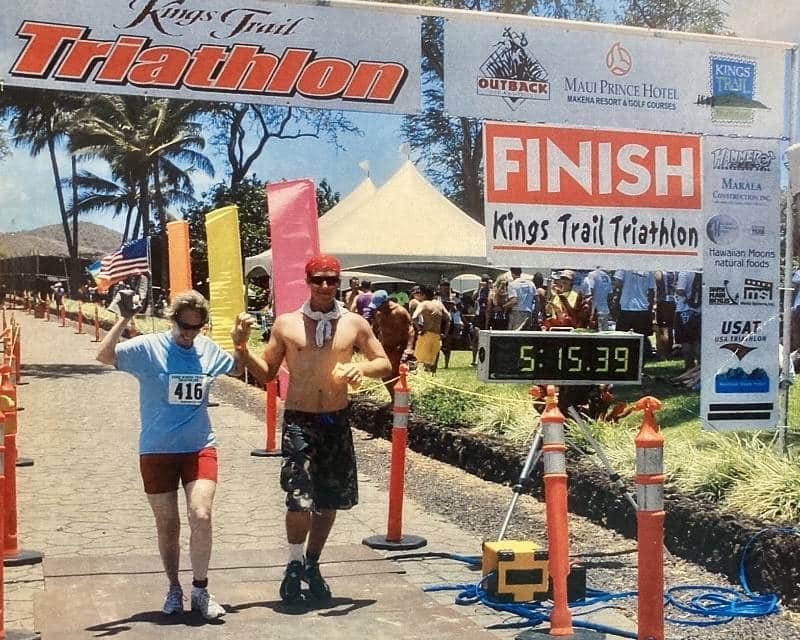Inspired to Swim, Bike, Run – Pat Hawks’ Triathlon Story

What has inspired Pat Hawks to take part in the sport of triathlon? To answer this, she took me back to her childhood.
Growing up in southern California, Pat loved to swim and surf in the Pacific Ocean. She also learned valuable life lessons from a mother who refused to give up, despite serious challenges.
After contracting polio at age two, Pat’s mother never walked. However, even though doctors told her she would never have children and not live past age 50, she raised a family and learned to drive a car. She also lived longer than everyone in her immediate family.
What is also remarkable about Pat’s mother is that she taught Pat to swim. Because of her mom’s exceptional upper body strength, Pat never won a swim race between her mother and her.
Seeing her mother accomplish so many things no one expected her to do inspired Pat. Today, Pat often dedicates her rides and runs to her mother, since these were things her mother could not do.
Pat is also determined to pass on her mother’s perseverance to her children. It’s working. Her daughter, Heather, tells others about the difficulty of keeping up with her mother. Pat hopes her children will pass on her legacy to the next generation.

Pat Hawks – Mother, Teacher, Writer, Hair Stylist and More
Pat has had a rich life, full of diverse experiences.
During a 20-year period in which Pat raised three sons and a daughter, she stayed physically active, albeit with different companions than today. Pat swam and biked with her kids. She also enjoyed water-skiing and running.
Pat was also a Girl Scout leader for the troop to which her daughter, Heather, belonged. One day, she learned that Heather and her friends were going to quit Girl Scouts. They no longer wanted to sell cookies, take part in parades, or do community service projects. They just wanted to focus on badges.
Rather than allowing them to quit, she negotiated with them. They would sell one box of cookies, complete one community service project of their choosing, and identify badge goals.
The first badge goal the girls chose was survival hiking. Through this, Pat learned that she loves hiking. She would draw on this love a few years later.
This experience also became the basis for one of several books she has written. Under Their Wings is the story of her time mentoring those in her daughter’s Girl Scout troop.
Work Outside the Home
Pat also worked as a hair stylist, retiring from the profession after 35 years. She did so when aerosol cans were prevalent and before chemicals carried warning labels and ventilation was required. She credits her decision to add ventilation to her salon for the good health she enjoys, despite what many of her peers have experienced.
After retiring from hair styling, Pat became a parenting teacher. In this role, Pat worked through the court system of the State of Hawaii to teach mothers and fathers how to be parents.
Following this, she became a yoga instructor for seniors, something she continues today. She leads classes both on-line and at a beach in Maui, Hawaii. She also offers a hot yoga class.

Joining the Triathlete Community
Suddenly, at age 50, Pat found herself newly divorced. She started ballroom dancing. And, remembering the fun she had hiking with the Girl Scout troop she led more that a decade earlier, she started a hiking club. She learned that physical exercise was a way to combat depression resulting from the divorce.
Around this time, she also met a friend in her 40s at work who was training for a half Ironman 70.3 triathlon. The woman invited Pat to train and do the race with her. However, after looking at the distances of each of the legs, Pat declined. After all, she hadn’t swum any significant distance for many years.
Not accepting this answer, Pat’s co-worker argued, “If you can hike thirty miles into the wilderness with a thirty-pound backpack for three days at 10,000 feet, you can do this.”
An Important Lesson About Training for Older Athletes
She initially started training for the triathlon with a group of younger, 40-year-old people. However, early in the training, she had a lot of knee pain when following the group’s training plan.
She visited her orthopedic surgeon, who was also the sports medicine doctor for the local high school. He told her she was pushing herself too hard.
Pat remembers him telling her, “You cannot train like the 40-year-olds. You are a senior. Do one session per day, not two.” She followed his advice and trained in one swim, bike, or run activity each day for three days. On the fourth day, she did yoga and rested.
Ironically, Pat, who was age 51, and another person in their 50s, were the only ones from the original training group who finished the race. Three of the people in their 40s dropped out before race day or didn’t finish the race because of injuries.
While she did not finish on the podium, Pat completed the race and each leg with time to spare. She walked away healthy, injury free, and happy.
Seeking To Inspire Others
Looking back, Pat saw how difficult it was to restart training after thirty years of raising an active and a busy family. It wasn’t until her last child graduated from high school she could include regular exercise into her schedule. Training for the first triathlon was hard. Really hard.
She never again wanted to restart from near scratch in building physical endurance. She was going to keep moving from now on.
After completing her first triathlon, she scheduled another half Ironman. For this race, she tried to convince her three sons to do the triathlon with her.
When they told her she was crazy for racing at this age, she suggested that the three brothers form a relay team, with each completing one leg of the triathlon.
Before race day, two of Pat’s sons had dropped out, leaving her 21-year-old son, Stacy, to race alone. Even with an injury, Stacy completed the triathlon on his own, saying “If one old lady can do it, I can do it”.

Inspired to Continue With Triathlon
Today, at age 68, Pat splits her time between Maui, Hawaii and several western states of the mainland USA. She continues to compete in sprint triathlons and marathons. She still enjoys ballroom dancing and hiking mountains in Hawaii and on the mainland. When we spoke, she was preparing for a century (100 mile or 160 km) bike ride in Maui, Hawaii.
Pat’s strategy for continuing to compete in triathlon is three-fold: (1) do some physical activity every day with a goal in mind, (2) eat well, and (3) destress to stay healthy.
She does this for many reasons. First, she believes that good health results from these goals and choices.
Second, she sees these choices as a way of both honoring her mom and passing on her mother’s legacy to her children. As her mother and grandmother impacted her, Pat hopes to inspire her children and others to make choices that will keep them healthy and physically active.
For Pat, there is actually one more source of inspiration to stay with triathlon. She loves the feeling of elation coming from finishing a race or reaching the summit of a mountain. Anticipating this feeling keeps her going whenever she is struggling during a training activity, hike, or race.
How Pat Trains for Triathlon and Other Endurance Activities
For Pat, what some call training is simply time to do physical activities that she loves. This self-coached approach is based on advice over the past 20 years from medical professionals, especially her orthopedic surgeon and sports medicine doctor and her chiropractor.
Since she believes consistency is key, Pat spends one hour each day either swimming, biking, running, or walking. Her belief about the importance of consistency is shared by many, including coach Tony Washington, whose advice on daily strength training can be found here.
On any day, you could find Pat going for a one mile swim in the ocean, a four-mile run/walk, or a one hour bike ride with some hills. She swims every other or every third day. And based on the advice of her doctor, she never runs over four miles.
She is also a believer in yoga for muscle flexibility and the body’s overall health. Pat is convinced that yoga is the crucial piece of her training, holding the keys to her being able to train for a sport as physically and mentally demanding as triathlon.
Yoga is so central to Pat’s ability to compete in triathlon that on the day before a race, she completes two yoga sessions, one in the morning and one in the evening. She does these to get the body tuned up and muscles toned. For her, this routine is key to safely running the race.
Some Weight Training
Pat also does some weight training, primarily to maintain bone density and prevent osteoporosis. This includes running with light ankle weight belts. For other weight training, Pat has learned to use lower weights with more repetitions. Sadly, her one experience with a personal trainer, in which he had her lift 50 pounds (23 kg) above her head landed her at a chiropractor.
Pat also considers hiking and ballroom dancing part of her training. “Hiking is especially good for building endurance.”
Choosing Health Through Nutrition
Hanging over the door in her yoga studio is a sign that reads “Food is our FARMacy”. She does not take supplements. Instead, Pat believes in juicing fruits and vegetables to get the vitamins and minerals needed to remain healthy.
Pat recommends new triathletes learn about nutrition and hydration alongside learning about swimming, biking, and running.
Having seen the terrible consequences of becoming dehydrated in other triathletes, Pat has become a stickler for staying hydrated, especially during hard exercise and races. To make sure she has adequate electrolytes, she likes coconut water because of its potassium content.
Her pre-race ritual includes consuming 1/2 liter of coconut water. She also carries her own water during the bike and the run legs to supplement that provided by the race organizer.
Pat has become so good at staying hydrated that, in a recent race, she finished with “my bladder ready to burst.”
Advice for Seniors Thinking About Triathlon
From the lessons learned on her triathlon journey, Pat offers the following advice for the over-50 person who wants to do a triathlon.
First, she says, talk to your healthcare professional about your plan. Pat bases this on the value of advice she received from her doctor when she was training for her first triathlon. For example, he advised her to start with a run-walk combination. He also took her shopping for the correct running shoes for her.
Second, Pat says, start slow, learn your limits, and keep at it. “You will be astounded at the improvements.”
Pat reminds us that as we start, realize that you can’t train like your 40-year-old self. Be careful about the weights you use in strength training. More repetitions (reps) with lower weight are both effective and will help prevent injury.
Once you have started, be consistent. Do some training every day, preferably with a friend or group of people close to your age. They will help to hold you accountable. Just remember to never compare yourself to anyone else.
Finally, Pat says that once you have decided to do a triathlon, sign up for a race and pay the entry fee. In most cases, this will prevent self-doubt from derailing your plan.
Remember, The Tortoise Won the Race
Pat’s advice is to be like the fabled tortoise, for whom slow and steady won the race. She remembers the accomplishments of her mother and grandmother. She appreciates that she can move and wants to stay active as long as possible.
If that is not enough, she need only look at those around her who are older, some in their 80s and 90s, that get up each day and start moving despite the many pains.
She is especially excited to see those who get back capability they thought had been lost for good. Pat remembers an 80-year-old woman from her yoga class who came into class one morning with fist in the air, proudly announcing “I just put on my pants without sitting down on the bed.”
Seeing other’s health and fitness, including strength and balance, improve through continued exercise and a yoga discipline is motivating.
What Inspired You To Do Your First Triathlon? To Continue?
What was the reason you did your first triathlon or are now planning to do it? What has kept you in triathlon or other multi-sport endurance events?
Please share what motivates and inspires you in the Comments below.
Comments: Please note that I review all comments before they are posted. You will be notified by email when your comment is approved. Even if you do not submit a comment, you may subscribe to be notified when a comment is published.
